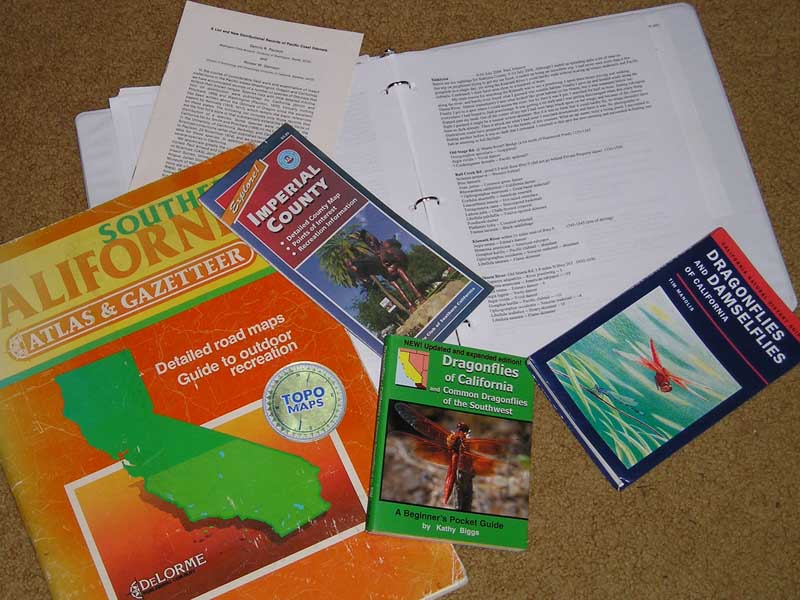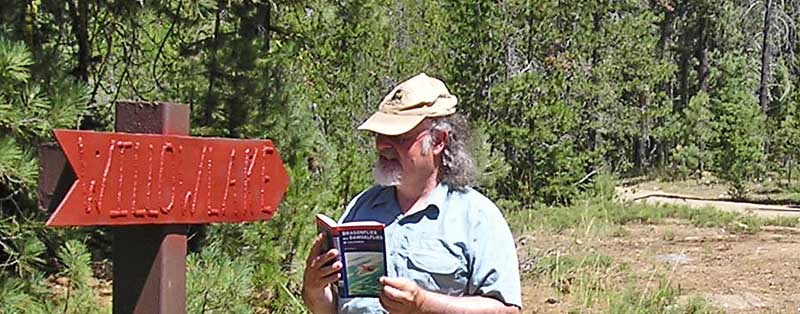
|
Planning the Big Year was a lot of fun for me. It wasn't done all at once, just a bit here and a bit there, using the many good resources available. Among them, key resources included:
All of these resources are shown in the photo above, plus one more that I created: a loose-leaf notebook of printouts of trip reports to various sites from the CalOdes archives, plus my compilation of planning information. |
|||||||||||||||
 |
|||||||||||||||
|
Basically what I did was this: take an ode like Paiute Dancer (photo above 5 July 2007 Zamboni Hot Springs). This is not a species found in Monterey County, and it would be a lifer for me. So I'd search the CalOdes archives for "Paiute" to get information on where and when it had been seen before [one does not add the word "Dancer" in the search because then you get information on all ten species of dancers in California]. I then edited the results to read like this:
I mostly used recent information from the last 2-3 years, but it was the weekly information in which I was interested, not the year. This tells me that I could expect to rather easily find the species between late May and early August, and gave me some possible spots. Once I had this information compiled for all of California's 106 resident species, I constructed a plan of trips needed from the last weekend of March through the third weekend in October. By carefully reviewing all the the options, and picking and choosing sites that seemed likely to bring maximum results, I constructed a chronology that had us odeing most of the weekends of the spring and summer (at least 6 of those weekend planned within Monterey County), excluded the ten days in late June when I knew were were going to fly to New England for a vacation. |
|||||||||||||||
|
|
|||||||||||||||
|
Of course, Willow Lake in Plumas County was critical. According to the information that I compiled, it was the only spot in the State for Belted Whiteface; one of only two spots for Sedge Sprite, Canada Darner, and Autumn Meadowhawk*; among the very few sites for Chalk-fronted Corporal; and a solid site for things like Shadow Darner and Dot-tailed & Hudsonian Whiteface. So I planned to hit Willow Lake three times: once each in July, August, and September. Of course my information was biased by what had been posted on CalOdes, but an advantage of primarily relying on the CalOdes reports were that these were places to which one could drive — plus the reports often gave detailed directions. Without getting too detailed, my plans included:
As already indicated in the listing above, plans changed as the year went by. Success at some spots precluded the necessity of going elsewhere while, conversely, misses at planned locales required re-arrangements. Ode Blitz III was not really planned to add any species, but it became important when I missed Desert Whitetail at other sites. We went to Santa Barbara Co. in July to look for Serpent Ringtail (success) but the visit to Piru did not yield Lavender Dancer, requiring later efforts with Paul Johnson in San Benito County. But, in outline, the basic chronology worked just fine. I didn't realize until after the year was completed just how similar my schedule had been to David Edwards & John Hall during their Big Year of 2005. One other item that influenced the planning was the start-up of air service by Express Jet from Monterey to San Diego and Ontario airports in May 2007. If one booked well enough in advance, the round trip air-flight price ($139) beat the cost of driving at $3/gallon, even counting the cost of a cheap rental car. So 3 of the 4 big southern California trips (Dos Palmas in May, Imperial Valley in August, Colorado River in October) were done by flying and renting a car. Rita went along on the May and October trips, and it still beat the cost of driving (not to mention the tedium of those distances; the Colorado River is about a 12 hour drive from my house, one way). In addition, I flew to Reno and rented a car for my first trip to the northeast in June. Finally, in planning the year, I had fun creating lists of species based on their perceived difficulty to me from my home in Monterey County. These were stratified by the alliterative names in the boxes below. I assumed that species not on any of these lists would be easy. Except for Powdered Dancer & Rambur's Forktail (both very easy in Imperial Valley) all of the following species required some degree of planning: |
|||||||||||||||
|
|||||||||||||||
|
all
photos & text © 2007 Don Roberson
|
HOME |
